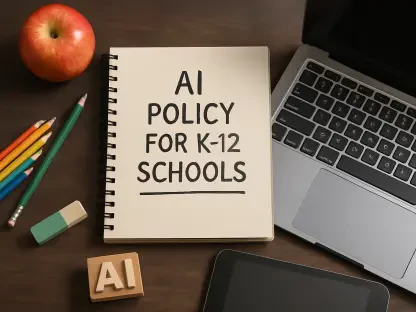In the wake of the COVID-19 pandemic, the Elementary and Secondary School Emergency Relief (ESSER) funding was a significant financial lifeline for schools nationwide. With $190 billion allocated towards educational recovery, the expectations were high. However, the results paint a picture of mixed successes and highlight areas needing critical reflection and improvement.
The Edunomics Lab at Georgetown University spearheaded an in-depth analysis, revealing how varied the outcomes were across different states. Despite the substantial injection of funds, the effectiveness of ESSER spending differed greatly, shedding light on the broader complexities of educational recovery.
Discrepancies in Academic Outcomes
High-Spending States with Positive Outcomes
The allocation of ESSER funds to states like Mississippi, North Carolina, and Tennessee reveals a narrative of successful implementation leading to academic gains. These states, which invested over $1,000 per student, saw marked improvements in reading and math scores from 2022 to 2023. The emphasis on strategic usage and targeted interventions in these regions underscores the pivotal role of school leadership in converting funding into educational progress.
Mississippi’s focused approach on reading instruction and North Carolina’s targeted math programs have been lauded. Similarly, Tennessee’s efforts in enhancing teacher training and supporting after-school tutoring programs have contributed significantly to the academic rebound. These examples highlight the potential for thoughtful, well-executed allocation of resources to stimulate educational recovery.
Despite their positive outcomes, these states also offer lessons in best practices. Effective goal-setting, regular monitoring of student progress, and adaptive strategies were essential in translating funds into meaningful academic improvements. This underscores that a one-size-fits-all approach is inadequate in addressing educational recovery needs across different states and districts.
High-Spending States with Limited Gains
In stark contrast, states like Nevada, California, and South Dakota also received ample ESSER funds but did not exhibit comparable academic improvements. This disparity suggests that merely the scale of spending is not enough; strategic goal-setting and competent oversight are equally crucial. These states struggled with diverse challenges, ranging from ineffective program implementation to delayed response strategies.
California’s sprawling educational system faced hurdles in uniform policy application, while Nevada’s urban-rural divide compounded the complexities of fund allocation and service delivery. South Dakota, with its unique demographic challenges, also struggled to translate funding into uniform educational gains. These scenarios exemplify the need for nuanced, context-specific planning.
The varied success rates among these states highlight the importance of local leadership and tailored approaches to spending. It is not just the availability of funds that matters but also how effectively these resources are managed and adapted to meet specific local needs.
Internal Resource Allocation Challenges
Inequities in Recruitment and Staffing
The influx of ESSER funds created an unexpected predicament in staffing across school districts. Wealthier schools within districts often filled vacancies more rapidly, leaving higher-poverty schools at a disadvantage. This internal competition exacerbated existing inequalities, highlighting the systemic issues in resource distribution.
Middle-class and affluent schools quickly capitalized on the funding, securing necessary staff and resources. Conversely, less affluent schools faced prolonged hiring challenges, impacting their ability to deliver consistent educational support. This trend amplified the difficulties higher-poverty schools had in pulling themselves out of the pandemic-induced educational slump.
The disparity in recruitment and staffing also underscores a broader issue within school districts: the tendency for wealthier institutions to perpetuate their advantages. By occupying essential roles more swiftly, these schools could maintain or even improve their educational offerings, further widening the gap between affluent and higher-poverty schools.
Strategic Missteps in Resource Allocation
Effective resource allocation is key to successful educational recovery. However, numerous districts demonstrated shortcomings in this respect. The renewal of contracts for edtech and tutoring services without due diligence in assessing their effectiveness resulted in missed opportunities and wasted funds.
Many districts rushed to extend existing contracts reflexively, focusing on immediate needs rather than long-term impact. While some districts benefitted from continued digital resources and tutoring support, others saw little to no improvements. This underlines the necessity for critical evaluation and data-driven decision-making in resource allocation.
Furthermore, the lack of rigorous assessment of supplementary services led to a misalignment between resources and actual educational needs. By failing to critically evaluate the impact of these services, districts not only squandered valuable funding but also missed chances to direct resources where they could produce tangible academic benefits.
The Role of Reading Instruction
Investment in Reading Disabilities
Identifying reading disabilities became a priority for many districts receiving ESSER funds. However, investments aimed at recognizing such disabilities did not automatically translate to better reading outcomes. The effectiveness of reading programs depended significantly on the quality of general education instruction.
Continuous professional development for teachers in the science of reading proved invaluable. Districts that focused on robust foundational instruction saw fewer students requiring special education services. This approach not only addressed immediate difficulties but also fostered long-term academic resilience.
Moreover, the emphasis on early identification and intervention for reading disabilities highlighted the need for a comprehensive and cohesive strategy. This strategy had to integrate professional development, evidence-based reading instruction methodologies, and ongoing support to ensure students’ reading capabilities were effectively addressed and improved.
Foundational Reading Instruction
The emphasis on integrating scientifically backed reading instruction in general education classrooms demonstrated substantial benefits. Schools that invested in core reading curricula and teacher training reported better literacy outcomes. This strategic realignment of resources towards foundational learning underlines the importance of targeted educational interventions.
Feedback from teachers and ongoing assessments helped refine reading programs, ensuring they met the challenges posed by the pandemic. These insights showcase how dedicated instructional investments can serve as a bulwark against widespread learning deficits.
By prioritizing foundational reading instruction, schools were able to equip students with the necessary skills to excel academically, creating a sustainable model for educational success. Such a focus not only addressed the immediate disruptions caused by the pandemic but also laid the groundwork for long-term improvements in literacy and overall academic achievement.
Broken Budget Processes Hindered Rapid Response
Misaligned Budget Cycles
One of the critical issues identified was the misalignment of school district budget cycles with real-time student needs. By the time standardized test results were released, many districts had already finalized their budgets. This lag hampered the ability to adjust spending plans according to emerging needs.
Districts often struggled to navigate this bureaucratic rigidity, finding themselves unable to deploy funds where they were most needed swiftly. The static nature of budget processes highlighted the need for more flexible, responsive financial planning mechanisms in education systems.
The misalignment also meant that districts could not adequately respond to the rapidly changing educational landscape during the pandemic. As new challenges and needs emerged, the rigid budget processes left little room for adaptation, slowing recovery efforts and hindering the effective use of ESSER funds.
Delays in Utilizing Allocated Funds
Many districts also experienced significant delays in utilizing their ESSER funds due to bureaucratic hurdles and administrative inefficiencies. This sluggish pace of fund deployment further hindered efforts to address urgent educational needs and implement timely interventions.
In some cases, districts struggled with procurement processes, which slowed down the acquisition of necessary educational materials and technology. Others faced challenges in hiring additional staff or coordinating extended learning programs in a timely manner. These delays underscored the importance of streamlining administrative processes to ensure swift and effective use of emergency funds.
The combination of misaligned budget cycles and delays in fund utilization highlighted the need for more agile financial management practices in educational systems, particularly in times of crisis. By addressing these systemic issues, districts can better respond to the evolving needs of their students and ensure that funding is used efficiently and effectively.
Conclusion
The mixed results of ESSER funding in post-pandemic school recovery reveal the complexities of educational recovery and the critical importance of effective resource management. While some states and districts successfully leveraged the funds to achieve significant academic gains, others faced challenges that limited their progress.
Key lessons from the successful states emphasize the importance of strategic planning, robust oversight, and targeted interventions in achieving educational recovery. Additionally, addressing internal resource allocation challenges and ensuring timely deployment of funds are crucial steps in maximizing the impact of emergency funding. By learning from these experiences, educational leaders can better navigate future crises and work towards a more resilient and equitable educational system.









